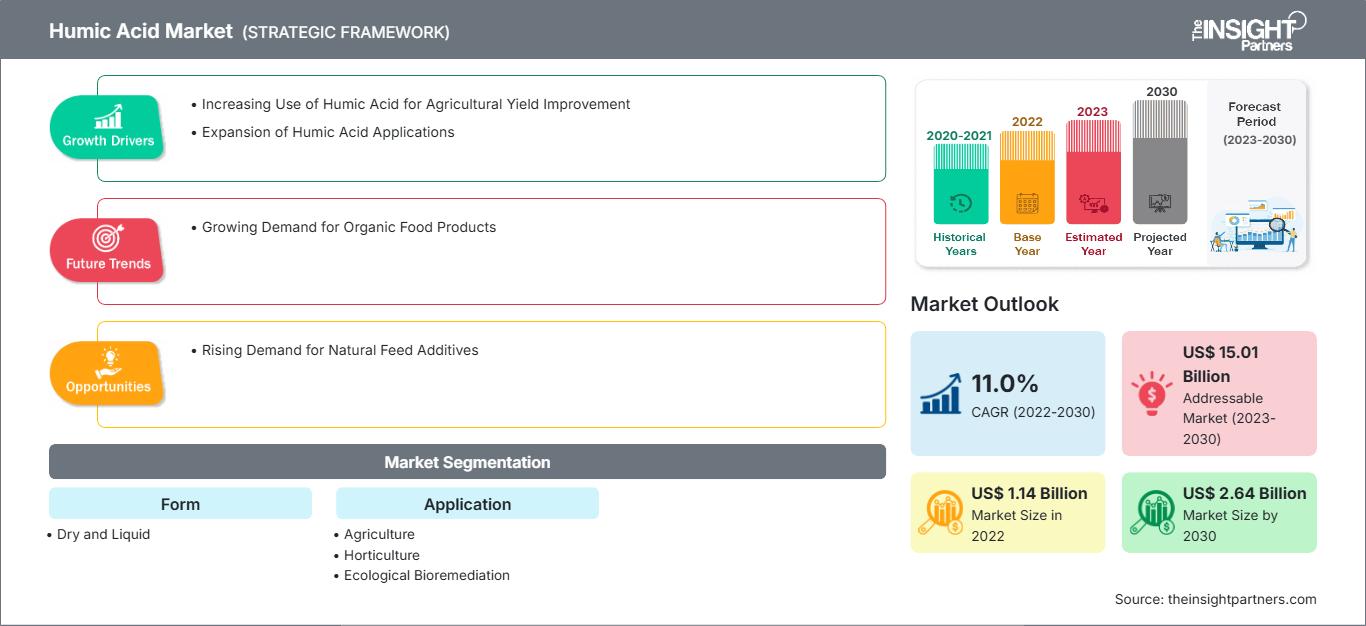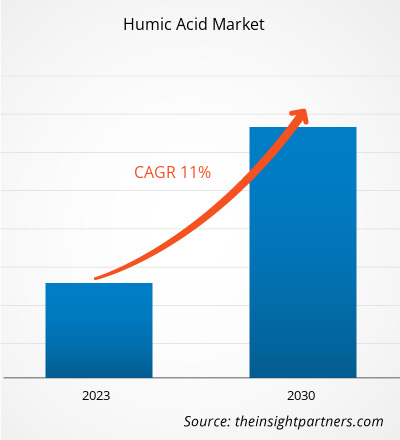[Forschungsbericht] Der Markt für Huminsäure wurde im Jahr 2022 auf 1.144,11 Millionen US-Dollar geschätzt und soll bis 2030 voraussichtlich 2.640,11 Millionen US-Dollar erreichen; von 2022 bis 2030 wird eine durchschnittliche jährliche Wachstumsrate (CAGR) von 11,0 % erwartet.
Markteinblicke und Analystenmeinung:
Huminsäure ist eine natürliche organische Verbindung, die aus zersetztem Pflanzen- und Tiermaterial gewonnen wird. Sie kommt häufig in Erde, Torf und Kohlevorkommen vor. Huminsäure ist eine komplexe Mischung organischer Moleküle, die eine Vielzahl funktioneller Gruppen enthält, darunter Carbonsäuren, Phenole und Chinone. Der globale Markt für Huminsäure wird in den nächsten Jahren voraussichtlich stark wachsen. Die steigende Nachfrage nach Bio-Lebensmitteln und nachhaltigen landwirtschaftlichen Praktiken treibt das Wachstum des Huminsäuremarktes voran. Huminsäure verbessert nachweislich die Bodenfruchtbarkeit, steigert die Ernteerträge und fördert Wachstum und Gesundheit der Pflanzen. Diese Vorteile treiben die Nachfrage nach Huminsäure in der Landwirtschaft und im Gartenbau an.
Wachstumstreiber und Herausforderungen:
Huminsäure stimuliert nachweislich das Wurzel- und Sprosswachstum und führt so zu einer erhöhten Biomasseproduktion. Sie fördert die Entwicklung von Seitenwurzeln, verbessert die Nährstoffaufnahmeeffizienz und steigert den Pflanzenstoffwechsel, was wiederum zu höheren Erträgen und qualitativ besseren Lebensmitteln führt. Huminsäure verbessert außerdem die Bodenstruktur, erhöht die Wasserhaltekapazität, verbessert die Nährstoffspeicherung und fördert das Wachstum nützlicher Mikroorganismen, was durch bessere Nährstoffverfügbarkeit und -aufnahme zu einer Verbesserung der Bodenbedingungen führt. Infolgedessen steigt die Nachfrage nach Düngemitteln, Bodenverbesserungsmitteln und Biostimulanzien auf Huminsäurebasis usw. Nach Angaben der Vereinten Nationen wird die Weltbevölkerung in den nächsten 30 Jahren voraussichtlich um ca. 2 Milliarden Menschen ansteigen. Sie würde von 8 Milliarden im Jahr 2022 auf 9,7 Milliarden im Jahr 2050 ansteigen. Mitte der 2080er Jahre würde die Bevölkerung mit etwa 10,4 Milliarden ihren Höhepunkt erreichen. Diese Statistiken alarmieren den Agrarsektor hinsichtlich des daraus resultierenden steigenden Nahrungsmittelbedarfs. Infolgedessen konzentrieren sich Landwirte weltweit darauf, ihre landwirtschaftlichen Praktiken zu ändern, um auf kleineren Anbauflächen hohe Erträge zu erzielen. Daher steigt der Bedarf an Düngemitteln in der Landwirtschaft, einschließlich solcher auf Huminsäurebasis, wobei der Schwerpunkt auf Pflanzenschutz und Ertragssteigerung im Agrarsektor liegt.
Passen Sie diesen Bericht Ihren Anforderungen an
Sie erhalten kostenlos Anpassungen an jedem Bericht, einschließlich Teilen dieses Berichts oder einer Analyse auf Länderebene, eines Excel-Datenpakets sowie tolle Angebote und Rabatte für Start-ups und Universitäten.
Huminsäuremarkt: Strategische Einblicke

-
Holen Sie sich die wichtigsten Markttrends aus diesem Bericht.Dieses KOSTENLOSE Beispiel umfasst Datenanalysen, die von Markttrends bis hin zu Schätzungen und Prognosen reichen.
Berichtssegmentierung und -umfang:
Der „Globale Huminsäuremarkt“ ist nach Form, Anwendung und Geografie segmentiert. Basierend auf der Form ist der Huminsäuremarkt in trocken und flüssig unterteilt. Der Huminsäuremarkt ist nach Anwendung in Landwirtschaft, Gartenbau, ökologische Biosanierung, Nahrungsergänzungsmittel und Sonstiges segmentiert. Der Huminsäuremarkt ist nach Geografie in Nordamerika (USA, Kanada und Mexiko), Europa (Deutschland, Frankreich, Italien, Großbritannien, Russland und übriges Europa), Asien-Pazifik (Australien, China, Japan, Indien, Südkorea und übriger Asien-Pazifik-Raum), Naher Osten und Afrika (Südafrika, Saudi-Arabien, Vereinigte Arabische Emirate und übriger Naher Osten und Afrika) sowie Süd- und Südamerika unterteilt. Mittelamerika (Brasilien, Argentinien und übriges Süd- und Mittelamerika)
Segmentanalyse:
Der Markt für Huminsäuren ist in trockene und flüssige Form unterteilt. Im Jahr 2022 hatte das Segment der trockenen Huminsäure einen größeren Marktanteil und wird voraussichtlich von 2022 bis 2030 eine schnellere durchschnittliche jährliche Wachstumsrate (CAGR) verzeichnen. Trockene Huminsäure, auch Humate genannt, ist in Form von Flocken und Granulaten erhältlich. Humate entstehen, indem Huminsäuren durch Dehydration in eine feste Form überführt werden. Da es sich bei Humaten um dieselbe Verbindung in einer anderen physikalischen Form handelt, haben sie ähnliche Vorteile wie flüssige Huminsäuren. Die trockene Form der Huminsäure wird häufig als Zusatzstoff in verschiedenen Nahrungsergänzungsmitteln und organischen Düngemitteln verwendet. Humate können den in Form von Nitrat vorhandenen Stickstoff in landwirtschaftlichen Erzeugnissen reduzieren. Humatpulver wirkt als natürlicher Bodenfestiger und Pflanzenwachstumsstimulans. Trockene Huminsäure ist zudem leicht zu lagern und erfordert im Vergleich zu flüssiger Huminsäure geringere Transportkosten.
Basierend auf der Anwendung ist der Huminsäuremarkt in Landwirtschaft, Gartenbau, ökologische Biosanierung, Nahrungsergänzungsmittel und andere segmentiert. Im Jahr 2022 hielt das Segment Landwirtschaft den größten Anteil am Huminsäuremarkt, während das Segment Nahrungsergänzungsmittel im Prognosezeitraum voraussichtlich die höchste durchschnittliche jährliche Wachstumsrate verzeichnen wird. Huminsäure verbessert die Aufnahme organischer und mineralischer Substanzen und bindet wasserlösliche anorganische Düngemittel. Landwirte benötigen Düngemittel, die den Ernteertrag steigern. Dies hat weltweit angesichts der zunehmenden Bemühungen, den steigenden Nahrungsmittelbedarf und die abnehmende Verfügbarkeit landwirtschaftlicher Flächen zu decken, an Bedeutung gewonnen. Huminsäure steigert die Bodenfruchtbarkeit und den Ernteertrag durch ihre natürlichen ölkonditionierenden Eigenschaften. Sie verbessert die Nährstoffaufnahme, die Wasserspeicherung, das mikrobielle Wachstum und die Bodenstruktur. Die Huminsäure-Anwendungsrate in der Landwirtschaft und im Gartenbau steigt rapide an, da sie dazu beiträgt, den Ernteertrag bei optimalen Kosten zu steigern. Dieser Faktor treibt den Markt für wasserlösliche Huminsäuredünger weltweit an.
Regionale Analyse:
Geographisch ist der Huminsäuremarkt in fünf Schlüsselregionen unterteilt: Nordamerika, Europa, Asien-Pazifik, Süd- und Mittelamerika sowie Naher Osten und Afrika. Im Jahr 2022 hatte Europa den größten Anteil am Huminsäuremarkt, und der Asien-Pazifik-Raum wird im Prognosezeitraum voraussichtlich die höchste durchschnittliche jährliche Wachstumsrate verzeichnen. Die Regierungen asiatischer Länder ermutigen Landwirte zur Einführung nachhaltiger landwirtschaftlicher Praktiken, indem sie Anreize bieten und in Forschung und Entwicklung investieren. Japan hat sich zum Ziel gesetzt, den Einsatz chemischer Düngemittel und Pestizide bis 2050 um 30 % bzw. 50 % zu reduzieren. Ebenso fördert die indische Regierung Biodünger durch verschiedene Programme wie die National Mission for Sustainable Agriculture (NMSA)/Paramparagat Krishi Vikas Yojana (PKVY), Rashtriya Krishi Vikas Yojana (RKVY), National Mission on Oilseeds and Oil Palm (NMOOP), National Food Security Mission (NFSM) und Indian Council of Agricultural Sciences (ICAR). Die Initiative der indischen Regierung dürfte den Huminsäuremarkt in Indien im Prognosezeitraum ankurbeln.
Branchenentwicklungen und zukünftige Chancen:
Nachfolgend sind verschiedene Initiativen wichtiger Akteure auf dem globalen Huminsäuremarkt aufgeführt:
- Im Oktober 2019 nahm Humic Growth Solutions Inc. eine neue Produktionsanlage in Shelby, Montana, USA, in Betrieb, um seine Huminsäure-Produktionskapazität zu erhöhen.
- Im Februar 2023 brachte The Andersons, Inc. eine neue Produktlinie granularer Mikronährstoffe auf den Markt: MicroMark DG. Diese technisch hergestellten Pflanzennährstoffprodukte verfügen über die Dispergiergranulat-Technologie (DG), die homogene, kugelförmige Granulate erzeugt, die sich leichter mischen und verteilen lassen und vor allem eine höhere Wirksamkeit erzielen. Das Unternehmen bietet Huminsäureprodukte in dieser Kategorie an.
- Im Juli 2020 schloss Black Earth Humic die Übernahme der kanadischen Humalite International ab. Diese Übernahme ermöglichte es dem Unternehmen, sein Produktportfolio zu diversifizieren und in den Bereichen Landwirtschaft und angewandte Huminsäureinnovationen zu arbeiten. Nach der Übernahme wurde der Firmenname in Black Earth Products Inc. geändert.
Huminsäuremarkt
Die Analysten von The Insight Partners haben die regionalen Trends und Faktoren, die den Huminsäuremarkt im Prognosezeitraum beeinflussen, ausführlich erläutert. In diesem Abschnitt werden auch die Marktsegmente und die geografische Lage in Nordamerika, Europa, dem asiatisch-pazifischen Raum, dem Nahen Osten und Afrika sowie Süd- und Mittelamerika erörtert.Umfang des Huminsäure-Marktberichts
| Berichtsattribut | Einzelheiten |
|---|---|
| Marktgröße in 2022 | US$ 1.14 Billion |
| Marktgröße nach 2030 | US$ 2.64 Billion |
| Globale CAGR (2022 - 2030) | 11.0% |
| Historische Daten | 2020-2021 |
| Prognosezeitraum | 2023-2030 |
| Abgedeckte Segmente |
By Form
|
| Abgedeckte Regionen und Länder |
Nordamerika
|
| Marktführer und wichtige Unternehmensprofile |
|
Dichte der Marktteilnehmer für Huminsäure: Verständnis ihrer Auswirkungen auf die Geschäftsdynamik
Der Huminsäuremarkt wächst rasant, angetrieben durch die steigende Endverbrauchernachfrage aufgrund von Faktoren wie sich entwickelnden Verbraucherpräferenzen, technologischem Fortschritt und einem stärkeren Bewusstsein für die Produktvorteile. Mit steigender Nachfrage erweitern Unternehmen ihr Angebot, entwickeln Innovationen, um den Verbraucherbedürfnissen gerecht zu werden, und nutzen neue Trends, was das Marktwachstum weiter ankurbelt.

- Holen Sie sich die Huminsäuremarkt Übersicht der wichtigsten Akteure
Auswirkungen von COVID-19:
Die COVID-19-Pandemie beeinträchtigte Volkswirtschaften und Industrien in verschiedenen Ländern weltweit. Lockdowns, Reisebeschränkungen und Betriebsschließungen in Nordamerika, Europa, im asiatisch-pazifischen Raum (APAC), in Süd- und Mittelamerika (SAM) sowie im Nahen Osten und Afrika (MEA) behinderten das Wachstum mehrerer Branchen, darunter der Chemie- und Werkstoffindustrie. Die Schließung von Produktionseinheiten störte globale Lieferketten, Fertigungsaktivitäten und Lieferpläne. Störungen in den globalen Lieferketten führten zu Rohstoffknappheit, was die Produktion verschiedener großer und kleiner Huminsäurehersteller behinderte. Die COVID-19-Pandemie brachte verschiedene wirtschaftliche Herausforderungen mit sich, darunter Handelshemmnisse und Zölle, Währungsschwankungen und regulatorische Herausforderungen, die das Wachstum des Huminsäuremarktes in verschiedenen Regionen behinderten. Ende 2020 und Anfang 2021 begann sich der Huminsäuremarkt zu erholen, da die Regierungen verschiedener Länder wichtige Maßnahmen ergriffen, wie beispielsweise gut koordinierte Impfkampagnen. Die Wiederaufnahme landwirtschaftlicher und gartenbaulicher Geschäftstätigkeiten und die Umstellung der Verbraucher auf Bio-Lebensmittel trieben die Nachfrage nach Huminsäureprodukten im Jahr 2021 an und trieben das Wachstum des Huminsäuremarktes voran.
Wettbewerbslandschaft und Schlüsselunternehmen:
Zu den führenden Akteuren auf dem Huminsäuremarkt gehören AGBEST TECHNOLOGY CO LTD, Agriculture Solutions Inc, Black Earth Products Inc, AGRICULTURAL AND MINING DEVELOPMENT SA, Faust Bio-Agricultural Services Inc, Humic Growth Solutions Inc, Humintech GmbH, The Andersons Inc, MYCSA Ag Inc und Grow More Inc.
- Historische Analyse (2 Jahre), Basisjahr, Prognose (7 Jahre) mit CAGR
- PEST- und SWOT-Analyse
- Marktgröße Wert/Volumen – Global, Regional, Land
- Branchen- und Wettbewerbslandschaft
- Excel-Datensatz
Aktuelle Berichte
Verwandte Berichte
Erfahrungsberichte
Grund zum Kauf
- Fundierte Entscheidungsfindung
- Marktdynamik verstehen
- Wettbewerbsanalyse
- Kundeneinblicke
- Marktprognosen
- Risikominimierung
- Strategische Planung
- Investitionsbegründung
- Identifizierung neuer Märkte
- Verbesserung von Marketingstrategien
- Steigerung der Betriebseffizienz
- Anpassung an regulatorische Trends






















 Kostenlose Probe anfordern für - Huminsäuremarkt
Kostenlose Probe anfordern für - Huminsäuremarkt